#Venus has no moons
Text
Happy 45th Birthday to cool auntie Minako Aino!
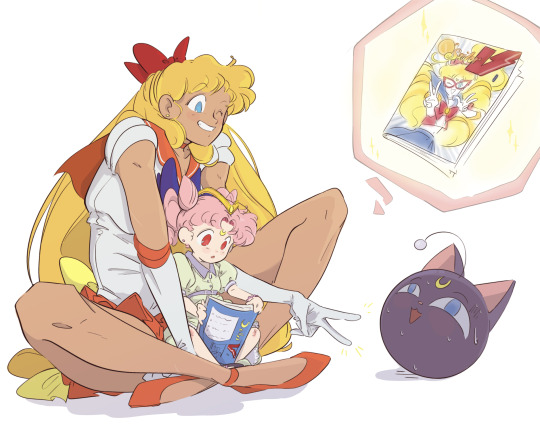
#sailor moon#minako aino#sailor venus#chibiusa tsukino#The sailor V manga is a rare item in the desolate future#Chibs has no idea what it is#but auntie’s on the cover so it’s cool!
687 notes
·
View notes
Text
Mercury and Career

I know. Saturn is the planet for careers, buhbuhbuh. But Mercury still rules how you think, which can help you find your chosen profession.
Yadda yadda yadda. All blah blah can't determine this and that. You know how it goes.
Sun conjunct Mercury (it'd be the end of the world if Sun forms a Sextile to Mercury) - Performers. Speakers. Anything that deals with people. Those bitches that you see motivate people or tell them what type of shit to do.
Moon - Mercury aspects - Acting. Theater. Singers. Siren for rent lmao I jest. Poet. Be a bard and see what it does for you.
Venus - Mercury aspects - Money, money, money. Must be funny. Dollar-sign-eyed hoes. Finance. Curator of arts. Anything that is related to deal-making and whatnot.
Mars - Mercury aspects - Tactician. Coach. Athlete. Instructor. Anything that gives them a reason to be hyper. Or shout.
Mercury - Jupiter aspects - Obviously, Professors. You'll see their names on your textbooks. Lawyers. Found an incomplete scripture? Ask these guys. They probably know what the first draft looked like.
Mercury - Saturn aspects - Corporate. Engineers. Judge. They can, and they will build your favorite stores. Free real estate.
Mercury - Uranus aspects - Scientist. Anything related to technology. Astronomer. Just throw these people in the wild and they'll come back having discovered Atlantis just by looking at the rocks they landed at.
Mercury - Neptune aspects - Design. Architect (Engineers' worst nightmare). Painting. Like Mercury-Moon, but more on the behind the scenes of it.
Mercury - Pluto aspects - Detective. Investigator. Psychologist. Let them sniff your partner's clothes and they'll know what they did last week.
#ha!#astro#astrology#astrology observations#astro observations#Sun conjunct Mercury#Moon-Mercury#Venus-Mercury#Mars-Mercury#Mercury-Jupiter#Mercury-Saturn#Mercury-Uranus#Mercury-Neptune#Mercury-Pluto
734 notes
·
View notes
Text


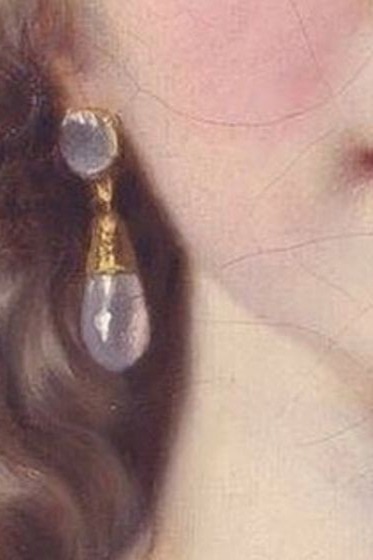

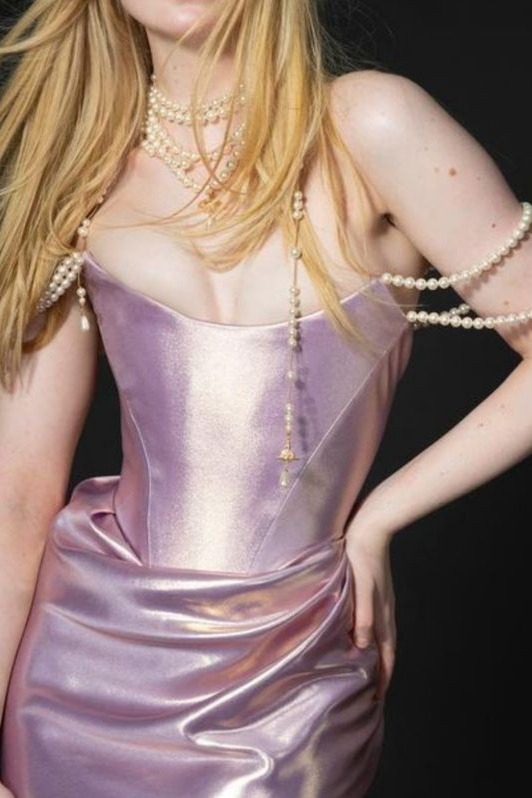
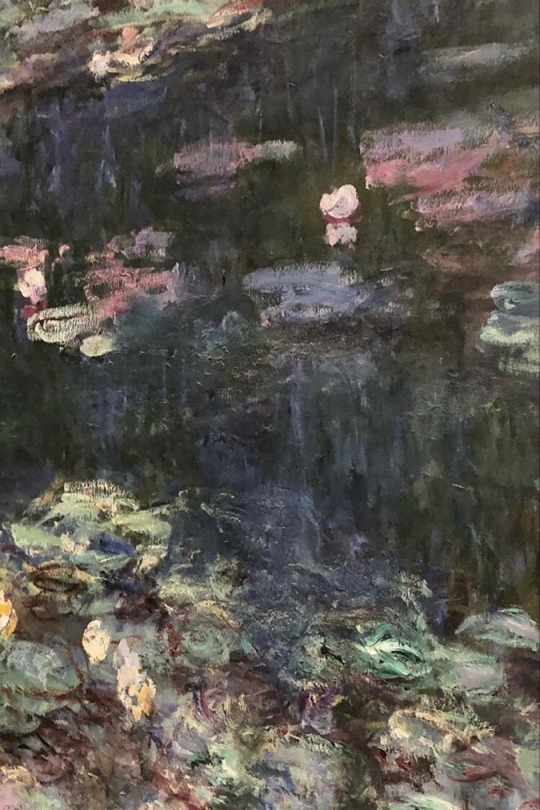
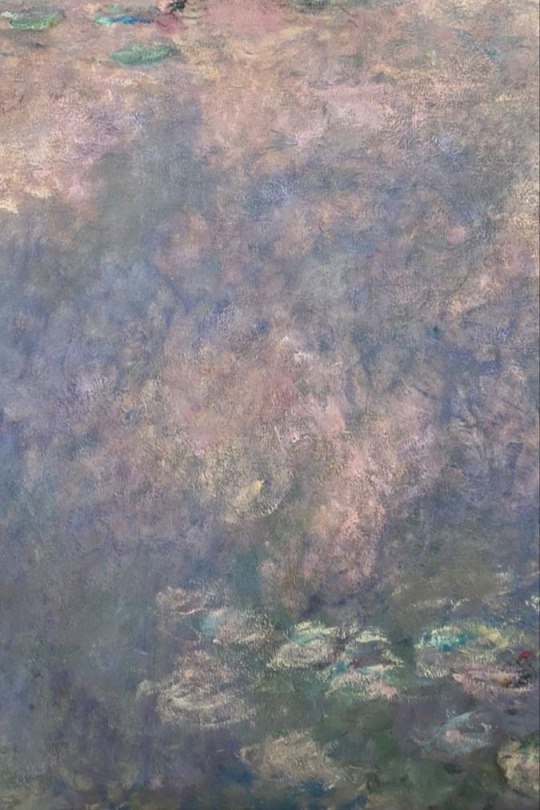


pisces sun · pisces moon · libra rising · pisces mercury · pisces venus · capricorn mars
#this has got to be my personal fav <333#neptuneslure#astro community#astro observations#astrology#astrology observations#astro notes#astrology notes#astroblr#astrology moodboard#moodboard#mb#moodboards#pisces sun#pisces moon#libra rising#pisces mercury#pisces venus#capricorn mars#art#elle fanning#pisces#aesthetic#astrology community#libra ascendant
117 notes
·
View notes
Photo
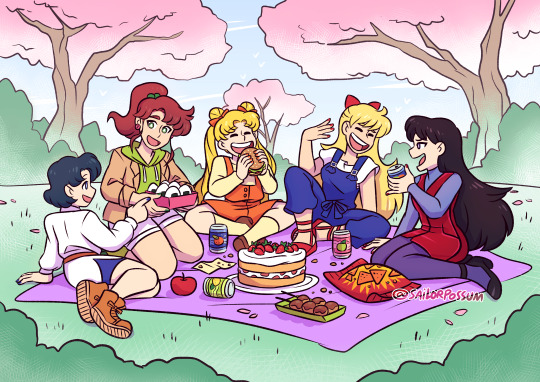
I made this one a couple years ago, but it’s still a favorite of mine. Planet girls having a lil picnic~
#my art#inner senshi#sailor moon#sailor mercury#sailor mars#sailor jupiter#sailor venus#usagi tsukino#ami mizuno#rei hino#makoto kino#minako aino#magical girl#illustration#artists on tumblr#picnic#park#sakura#oh look this one has a background
2K notes
·
View notes
Text
Astrology Observations:
-Found a trend with Aries Moon/Venus (honorable mention Leo Mars) to be into BDSM or more rough type of sex
-People with Pisces placements in big 3 are more selfish than other placements, though people they let into their lives don’t seem to mind. Pisces in Big 3 aren’t usually shy about what they want
-Sagittarius in Big 3 always seem to have the opportunity to either travel or experience unique things with basically no cost to them. Always seeming to stem from some type of pure good luck and/or charismatic nature (them knowing someone who knew someone got them backstage/ got a job that lets them travel for free/etc)
*Bonus: Sagittarius in big 3 seem to have the ability to rub luck off onto people (whether good or bad depends on the Sag in my opinion)
#i dont mean selfish in a negative manner for pisces#i just feel they have an idea of what they want and they’ll figure out how to get it#even if its a little delusional or selfish#also i feel Sagittarius cant rub luck off on each other#like every sag has their own type of luck and other sags just cant enter that vibe#i guess if that makes sense#i do however feel like they can elevate their vibes or like balance them#astrology#leo mars#aries venus#aries moon#Sagittarius#Sagittarius moon#Sagittarius sun#pisces#pisces sun#pisces moon#astrology observations#Sagittarius rising#pisces rising
631 notes
·
View notes
Text
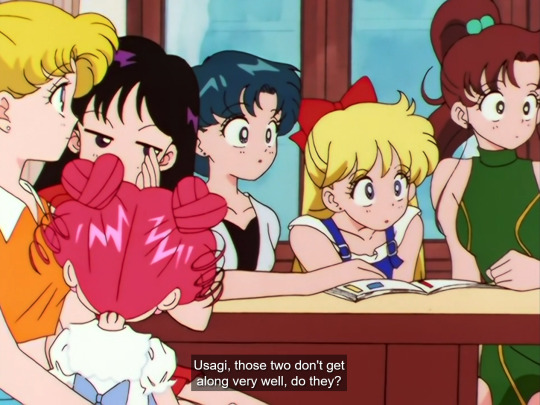


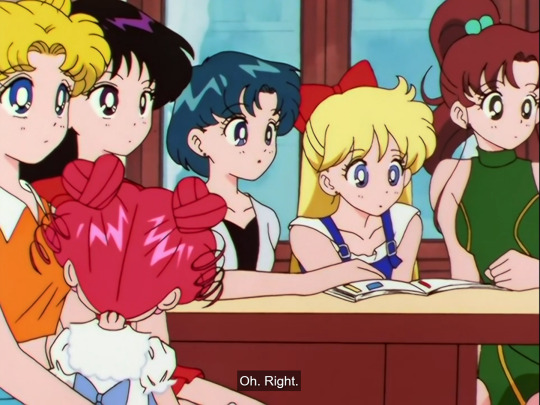
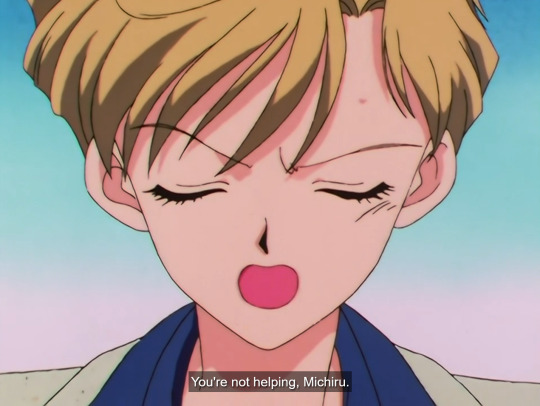
everyone here is so stupid and the only one winning is Michiru because she got the drama she wanted
#Usagi thinking that its NEWS that Haruka 'doesn't like boys'#GIRL WHAT#MAKO HAS LITERALLY GONE ON A DATE WITH HER#YOU ALL KNOW SHE AND MICHIRU ARE DATING#sailor moon#sailor moon spoilers#sailor uranus#sailor neptune#sailor mars#sailor venus#sailor mercury#sailor jupiter#haruka tenou#michiru kaioh#usagi tsukino#rei hino
285 notes
·
View notes
Text
Hello there, I am a space nerd, a fact I’m sure no one guessed from the fact that I go by Stars on the internet. I am here to explain how the moon works, because I think it’s cool and also something that most people don't know. This is mostly an infodump just for fun, but may also be vaguely useful for artists, writers & stargazers.
By “how the moon works,” I mean that although pretty much everyone knows about the moon’s phases, not everyone really gets how they affect things like when & where the moon is in the sky. See: the common idea that the sun is in the sky in the day, and the moon is in the sky at night. You know this isn’t strictly true if you’ve ever seen the moon in the sky in the daytime, but do you know how it actually works? If I gave you a moon phase and a time of day, would you be able to tell me whether the moon was in the sky or not?
I am here to (hopefully) explain how you can do that! With scribbly diagrams! Please join me under the readmore if you would like to come to my TED talk.
First of all, to avoid any accidental curse-of-knowledge assumptions on my part, let me define some terms!
First off, the phases of the moon, which you probably know most of, but bear with me. A “full moon” is when the moon is fully illuminated and appears as a circle in the sky. A “gibbous moon” is when the moon is more than half full, but not completely full—it appears large and roundish, but not a circle (not everyone knows the name for this one). A “half moon” is when the moon is half illuminated and appears as a semicircle—this one has some other names that I’ll get to in a second. A “crescent moon” is when the moon is less than half illuminated and appears as a concave curve. A “new moon” is when the moon is completely dark from Earth’s perspective and can’t be seen in the sky.

Also, “waxing” is when the moon is transitioning from new to full, or getting bigger in the sky, and “waning” is when the moon is transitioning from full to new, or getting smaller in the sky.
Speaking of “half moon,” I frequently confuse friends by calling this a “first quarter” or a “third quarter” moon. Those names refer not to the illumination of the moon but to the full cycle of phases. If you think of the moon phases as split into four quarters, starting from zero at a new moon, then halfway to full is 1/4, full is 1/2, halfway back to new is 3/4, and then we’ve reached the end/beginning of the cycle with another new moon. So one of the half moons is a first quarter moon, and the other (with the other half illuminated) is a third quarter moon.
This is where I have to add a disclaimer—I am in the northern hemisphere, and I am familiar with astronomy in the northern hemisphere. If you are in the southern hemisphere, to you, I am looking at the moon “upside down.” Yes, really. If you’re using my diagrams, flip them upside down. I’ll try to be clear when I’m talking about stuff that flips between the hemispheres, but it’s something that I struggle to wrap my head around too, so apologies if I’m confusing or miss something.
So, here’s a diagram of the moon phases to show you the difference between first and third quarter moons, but if you’re in the southern hemisphere, please flip it over to see what they would look like for you. (The chronological order still goes in the same direction as the arrow, the moon itself is just the other way in the sky.)
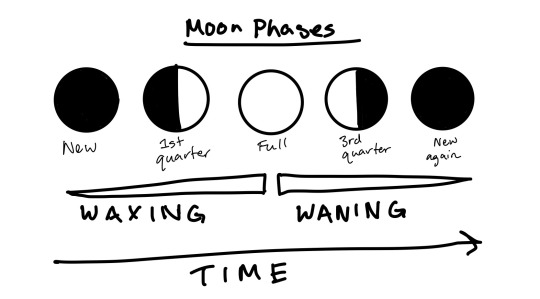
The fun trick I was taught to remember which way the cycle goes is “light from the right.” (Southern hemisphere people, you’ll have to flip this one.) Light, or shadow, moves from the right edge of the moon to the left. So if the moon is a crescent and the right edge is lit up, it’s waxing, or moving towards full. If the moon is a gibbous with a dark right edge, it’s just past full and will be waning towards the third quarter over the next few days. If you look at the diagram above (and imagine the crescent and gibbous phases transitioning in between), this might be easier to imagine.
Like I said, for the southern hemisphere this would actually be “light from the left.” If you’re near the equator and the moon is overhead, you could use “light from the west,” because that’s secretly the real rule. Another thing that’s useful to know for stargazing—the moon, sun and planets follow a path in the sky called the ecliptic, which is roughly over the equator. (Not exactly—it wiggles around relative to earth’s surface, because of the tilt of the earth’s axis that causes the seasons, but it stays near the equator.) If you’re standing in the northern hemisphere, the equator is south of you, so the ecliptic is also in the southern part of the sky. When you look at the moon, it will always be in the south, so the west-facing side of the moon will always be to your right. Likewise, if you’re in the southern hemisphere, the moon (and sun, and planets) will always appear in the northern half of the sky, so west will be to your left. Light moves across the moon’s surface from the west to the east.
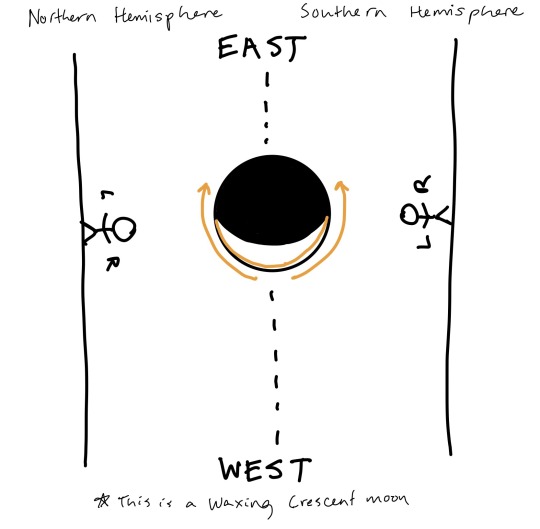
Now you can impress people by looking at the moon and saying, “Oh look, what a lovely waxing gibbous!” (I don’t actually know if the is impressive, but I do it all the time. For bonus points, get an app on your phone that tells you the phase of the moon and check it frequently so you can plan when to stargaze. Then you can casually mention that the moon will be full in a couple days when it’s not even in the sky, and maybe people will think you’re a werewolf.)
Now that I’ve explained the moon’s phases, I get to explain how they’re related to the time and place that the moon is in the sky. See, most people (I assume) don’t think twice about things like, say, a book describing a crescent moon in the sky overhead at midnight. But that actually can’t happen! And it has to do with the moon’s position in the 3D solar system, and how that maps onto our sky. This is kind of hard for me to explain without a lot of 3D hand gestures and pointing at the sky, but I’m gonna do my best to show it in two dimensions.
So, most people probably know that the moon’s phases are caused by the sun’s light illuminating half of the moon, and since the relative positions of the moon, sun & earth change throughout the month, the half that’s illuminated moves around the moon and changes how it looks from our viewpoint. So, a very basic rule: the side of the moon that’s illuminated is the side that’s facing the sun.
So, when the moon is full, that’s because the side that faces us is also facing the sun. This means the sun is directly opposite the moon. Here’s a very scientific diagram:
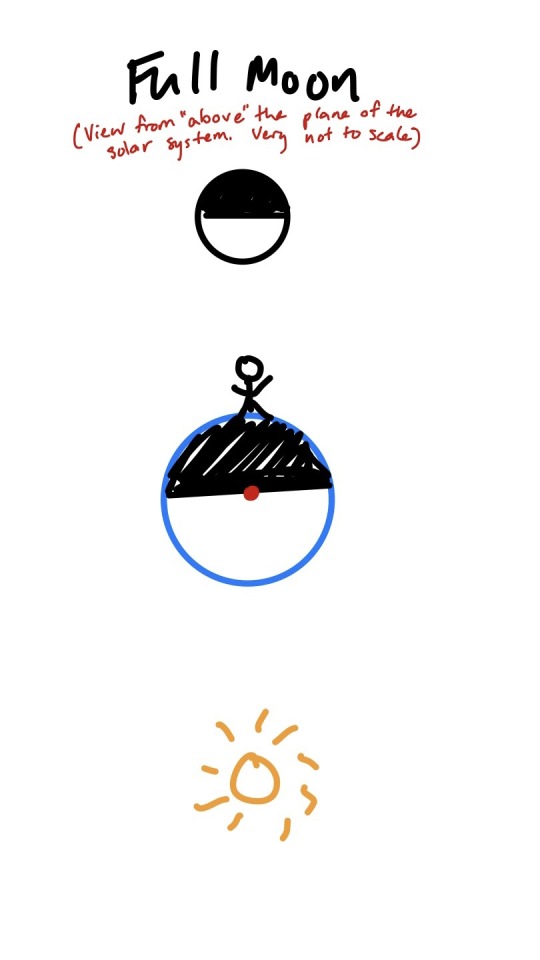
In case it’s not clear, this is a “top-down” view of the solar system where the moon, earth and sun are all in the same plane (in this case it doesn’t matter if we’re looking at the north or south pole, the positions would look the same). It’s also obviously not to scale and very simplified, but the point is to demonstrate that the moon is opposite the earth from the sun.*
The little person on the earth is of course spinning around as the earth rotates once per day. But at this point in the lunar month, you can see that when they are on the side of the earth where they can see the moon, they are also on the side facing away from the sun. When the moon is full or close to full, it’s opposite the sun—it rises around sunset, sets around sunrise, and is at its peak in the sky around midnight. This is how lots of people tend to think of the moon rising and setting, but it’s only true when the moon is close to full!
If that doesn’t make sense, here’s a diagram of when the moon is at the opposite point in its cycle, a new moon:
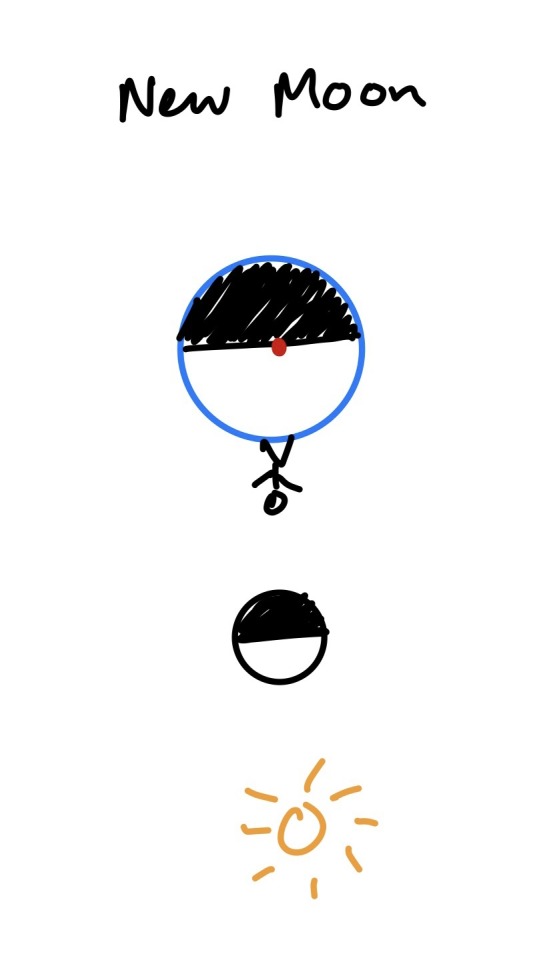
When the moon is new, the side that faces the earth is dark, which means the opposite side is facing the sun. The moon is on the same side of earth as the sun is. The little person spinning around the earth won’t see the moon in the night sky, because the moon is close to the sun in the sky,* and it’s actually rising in the morning and setting in the evening at this time of the month! You can’t easily see the moon when it’s new, but it might be visible a few days before or after this as a crescent. You’ll only see a crescent moon in the sky during the day, or close to dawn/dusk—it will be close above the horizon where the sun has just set or is about to rise. (The light edge faces the sun, so if it’s near the horizon in twilight sometimes it will look like the light edge is actually pointing down, with the tips of the crescent pointing up in the sky.)
*A side note on eclipses: My diagram is oversimplified! The moon, earth and sun aren’t actually all in the same plane all the time, they’re slightly misaligned. So even when I say the moon and sun are “directly” opposite each other, or aligned, they aren’t lined up perfectly enough to cast shadows on each other most of the time. When they do line up perfectly at the right time, that’s when you get a solar eclipse (when the moon is new) or lunar eclipse (when the moon is full).
Okay, so when the moon is full it’s in the sky at night, and when the moon is new it’s in the sky during the day. What about in between?
This is where it gets a little confusing, especially for those of you in the southern hemisphere, who are going to have to flip everything I say. Apologies in advance, but it kind of hurts my head even to explain how this works in my own half of the sky.
So, when the moon is half-full, at the first quarter and third quarter of the phase cycle I explained above, the sun’s light is coming (from our perspective) from the side. The moon is ninety degrees away in its orbit from full or new, and the sun’s light is effectively perpendicular to our viewpoint, instead of parallel. This time it matters which way we’re looking, so these are a top-down view from the northern-hemisphere side. If you’re in the southern hemisphere, I think you can flip which is the first & third quarter to make this accurate.

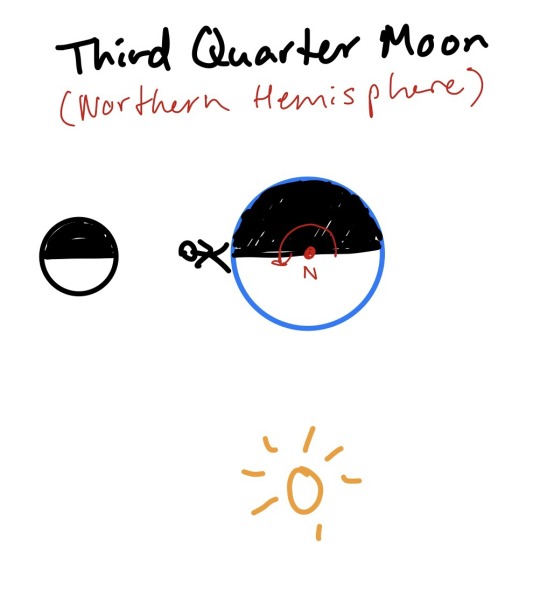
As you can see, when our little person is spinning around the globe, they’re going to be seeing the moon high in the sky right around the line between night and day. From a northern perspective, the earth spins counter-clockwise (vice versa from the south), so if you picture the person spinning around their little earth, you can see that the first quarter moon is going to be visible when they’re spinning from light to dark (sunset) and the third quarter moon is going to be visible when they’re spinning from dark to light (sunrise).
Bonus fun trick: If you remember the rule of “light from the right” in the northern hemisphere and how that determines the order of the phases, and look at these diagrams again, you can figure out which direction the moon orbits the earth from this viewpoint. (This is, in fact, the only way I can remember which direction the moon orbits the earth, despite being far more complicated than just memorizing it. If you’d like to make a game of it, I’ll put the answer at the bottom of the post).
Remembering how this looks from this top-down floating-above-the-earth perspective is hard, but you don’t really have to. I only explained it so it would make sense when I went back to my earlier visualization, from when I was explaining how “light from the right” works. I’m a very spatial learner, and I like picturing things relative to my own body, so this is how I remember when the different phases of the moon appear in the sky:
Imagine you’re standing, facing the ecliptic, where the sun and the moon travel through the sky. In the northern hemisphere, you’re facing south, with east to your left and west to your right. Imagine that the sun has just set, falling beneath the horizon to your right. Imagine that the moon is full, and hopefully I’ve explained well enough that now you know where it will be—cresting the horizon at your left. Imagine the opposite too—the sun is rising in the east at your left, as the full moon sinks in the west at your right. The new moon’s position, if you’d like to visualize that, is effectively the same as the sun.
Now, the difference between the two half-moons. Light comes from the west—in the northern hemisphere, your right—so when the right half is illuminated, it’s the first quarter of the lunar month, waxing to full, and when the left half is illuminated, it’s the third quarter, waning to new. One is high at dusk and one is high at dawn. Which is which?
You’re facing south. Picture a first quarter moon, right side lit up, at its peak in the southern sky. The light side is always facing the sun. Where is the sun? It must be to your right, touching the horizon in the west, setting. The first quarter moon is in the sky before, during and after dusk.
Picture a third quarter moon, left side lit up, at its peak. The light side faces the sun. The sun is to your left, touching the horizon in the east, rising. The third quarter moon is in the sky before, during and after dawn.
When I imagine this, I’m standing on my back porch, where I often go outside and stargaze. My telescope is small and one of the few things it can see with any detail is the moon. I want to be able to look at the moon just after dark, without having to stay up too late—and this memory device, of facing south and imagining the sun at my right hand to the west, is how I remember that the first quarter is the best time for me to observe the moon. It will be high in the sky at sunset, easy for me to see over the houses and trees.
If you remember that the moon waxes and wanes from the west (right in the north, left in the south), then you can fill in all the gradations of crescent and gibbous moon between the four main quarters. (As an example, if I wait a few days past first quarter to go outside and look at the moon, it’s waxed into a gibbous moon and it rises later in the evening, peaking in the sky closer to midnight. Another example: a waxing crescent is between a new moon and first quarter, so it will trail behind the sun and be above the horizon in the southwest at sunset.)
I hope that all of this makes sense and is useful to someone, whether for figuring out when you can observe the moon and where in the sky to look, or for thinking about how to place it in the sky in your writing and art. If nothing else, I hope I have brought you entertainment, and/or ruined the way the moon works in Minecraft for you forever. (It rises and sets directly opposite the sun!! Even when it’s a new moon!!! Light doesn’t work like that!!)
And finally, if you were trying to guess, the moon orbits the earth counter-clockwise if you’re looking down from the northern side.
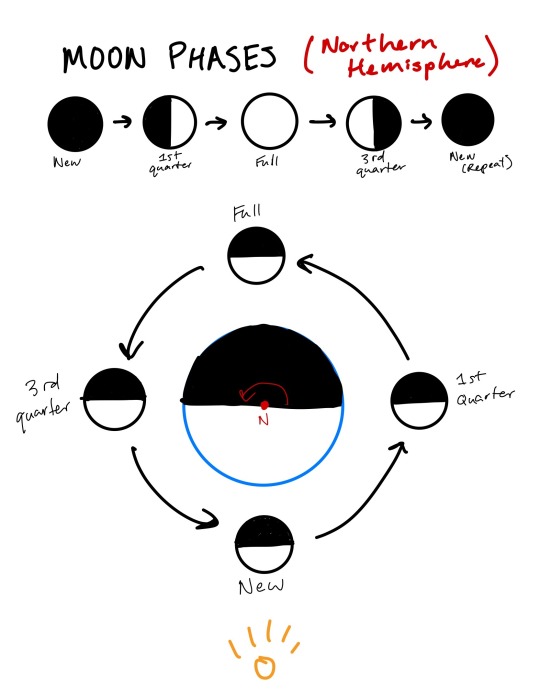
#stars has thoughts#space#the moon#amateur astronomy#thank you for coming to my ted talk#and thanks discord friends for saying 'write the moon infodump post!!'#when i was like 'i wonder if i should write a moon infodump post'#i am a humble space nerd slash backyard astronomer with a 4inch scope#but explaining how i visualize and remember space stuff in simple terms is one of my favorite things to do ever#i could do a bunch of other posts about stuff like this. why venus is the morning star. how telescopes work (explain it like i'm 5 edition)#perhaps i will#undescribed#(i will try to come back with image descriptions later but i have already done all the explaining of visual concepts with words#that i can manage today. apologies)
72 notes
·
View notes
Text
#polls#tumblr polls#my polls#poll time#planets#solar system#space#mercury#venus#earth#mars#jupiter#saturn#uranus#neptune#sun#moon#planet#i hope this hasnt been done before...#it probably has tbh lmaoooo#oh well#you bitches LOVE to press buttons
27 notes
·
View notes
Text
Idk if it's because her Mars is on my Mercury but sometimes I'd hear a Olivia Rodrigo song and I realize she explores topics that I often think about that others rarely (if ever) talk about.
Like a few years ago I started obsessing over the fact that every relationship is just rehashing the pevious one and how fucked up it is and how mentally uncomfortable that makes me feel and then I heard she has a song about it (Deja Vu). Or I like how she explores themes of envy and jealousy towards other women, which, especially in this day and age, is a big no no cause you may come off as a "not a girl's girl", but like???? These feelings are normal???? And I think about it a lot. Or not avoiding admitting that one does have obsessions over your partner's exes and stuff. Like jealousy in general is one thing, that is explored in music a lot, but not in the context of ex partners I feel.
#idk just some thoughts#i have moon square saturn#she has moon square venus#that's basically having bad experiences with other girls and NOT feeling like a girly girl and stuff#and having issues with comparisment#so i relate to it a lot even tho she's SO much younger than me#random#astrology
9 notes
·
View notes
Text
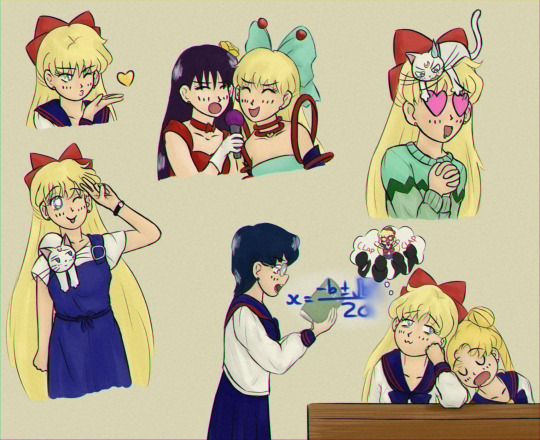
Minako Doodles
#sailor moon#minako aino#sailor venus#usagi tsukino#rei hino#sailor mars#ami mizuno#sailor mercury#she's 16 and spring has come!
16 notes
·
View notes
Text

sailor venus! ☀️
#illustration#blackartists#digital art#blackart#art#digital media#stylized#myart#medibang paint#medibang paint pro#care bears#carebear fanart#sailor senshi#sailormoonxcarebears#sailor moon#sailor venus#inner senshi#minako#minako sailor moon#this was so much fun but I think my style has changed a bit??? my consistently w art is so erratic sometimes#magjicqal
38 notes
·
View notes
Text
I’m sure this is underwhelming for everyone, but I’m an intermediate artist and I gotta post something to get out of this art block. Thank you to everyone for the support on the last post, it was unexpected, but definitely appreciated! Also hi! I love sm, as u can prob tell and I like posting some darker art too, so if ur into that feel free to stick around.
//tw: blood. I’ll hide the image if it bothers any1
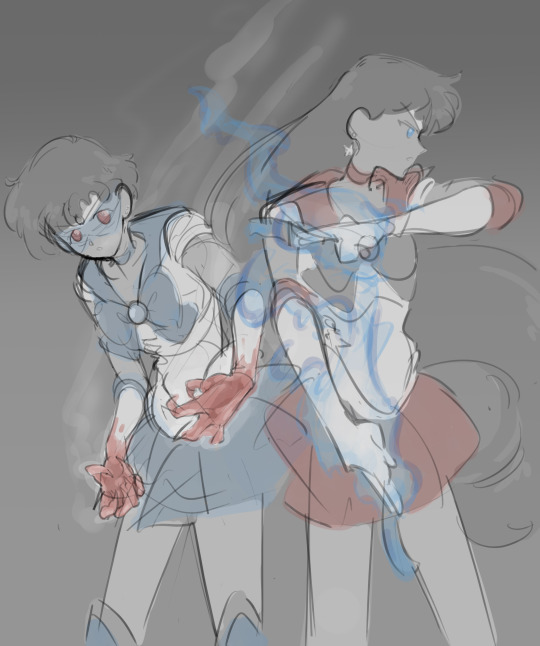
#sailor moon#sailor mars#sailor mercury#rei hino#ami mizuno#power color swap yay#Had this idea in mind for a while and I wanted to keep tru to their elements#So mars has blue fire#And since I hc Mercury as controlling the temperature of liquid I went for blood#I’ll prob make a Venus jups one too cause apparently green gold is a thing!
97 notes
·
View notes
Text
Short stuff about the stars and some shit

You know the drill.
➼ Just starting out on Astrology? Here's a cheat sheet:
Angular Houses (1st, 4th, 7th, 10th) are related to the "Self". I relate this to the foundations of one's self.
Succedent Houses (2nd, 5th, 8th, 11th) are related to the "Material". I relate this to the desires of a person.
Cadent Houses (3rd, 6th, 9th, 12th) are related to "Knowledge". Oddly, I relate this to travel.
➼ This is one of the reasons why I don't travel long-distance whenever Mars goes through any Mutable houses. If there is no other choice, I do my best to be careful.
The last time that Mars entered my 12th House, I got mugged. LMAO.
➼ I know (I think) I've talked a lot about Mercury-Uranus people but they're just so complex. Their mouths have no breaks but they're the most understanding.
➼ It's wild that Christopher Lee has Jupiter conjunct Saturn (8 degrees but hey, it's still something) in his birth chart. Not that I have further input on this, it's just.. wild. It makes sense.
➼ I knew Giancarlo Esposito is a Moon in Leo native the first time I saw him on Breaking Bad. No one can tell me that all Leo moons don't have that faux eyeliner on top. That, or they have short but thick eyelashes.
➼ I never realized this, but Taurus placements really have beautiful necks. Lately, uh, I find myself staring at Gregory Peck and Vincent Price's necks for no reason.
➼ Aries + Aquarius combination in a Natal chart is The Weeknd's album personified. Whatever album it is that you're thinking of, it'll probably fit. Angsty sad bois/gworls.
➼ Traditional method is recommended here. If you know someone whose Ascendant is two signs away from yours, chances are they'll be your ride or die. That's because your own ascendant will fall on their 11th house, and their 1st house will fall on your 3rd house. This is the "sharing the same single brain cell" synastry.
➼ Venus in an Air sign is unhinged when they find someone attractive. Shameless, even. There is something with the way they discuss the person they're interested in that cracks me up.
That's it. I'll go back to the aether now. Thanks for reading!

Photo by rose-of-pollux
#astro#ha!#astrology observations#astro observations#astro notes#angular houses#succedent houses#cadent houses#mercury-uranus#jupiter conjunct saturn#moon in leo#leo moon#taurus placements#aries placements#aquarius placements#11th house synastry#3rd house synastry#venus in an air sign#venus in gemini#venus in libra#venus in aquarius#vincent price and gregory peck can throw me like a ragdoll and I'd thank them
426 notes
·
View notes
Text
after a day of hanging out with people I don't Really like and performing friendliness and superficial connections, all a man like me craves is interaction with my lovely mutuals and my beautiful fictional man
#I'm having a sleepover this week 😈 told the people I want to get WIZARD HIGH. and they laughed.#they were like. okay never heard that one before.#also my bi man colleague has a very intriguing zodiac chart. air sign sun & venus? earth sign moon rising and mars. insanity
11 notes
·
View notes
Photo
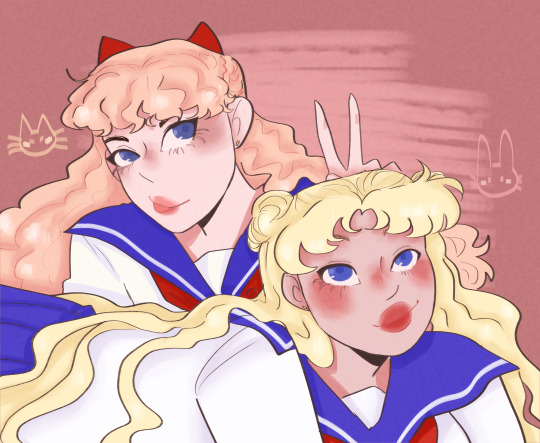
cat and rabbit 💖
i sketched this for lunar new year and then forgot that was the idea until i was almost done :’)
#originally was just gonna be a year of the bunny usagi thing but minako has big cat vibes#look at her bow cat ears#fun fact all the scouts are year of the horse#so am i hehe#idk how accurate that is bc supposedly theyre ALL born in 1978 even like the outer senshi?#that cant be true#anyway inner senshi at least are year of the horse#minako aino#usagi tsukino#sailor moon#sailor venus#pgsm#rill'sart
49 notes
·
View notes
Text
you'll really just see me being in solidarity with people I share astrological placements with 😭❤️- like best believe my favorite people in the world has a placement they share with me, in a group of people i have a favoritism yes
#bere.txt#astrology#you'll really just see me automatically having the aquarius person in that group be my favorite such as in music groups etc singers painter#writer etc like those are my fellows bro#scorpio moon writers and artists#scorpio rising and cap venus and taurus mars celebrities you name it#heck even the outer planets like slay let's go#even the asteroids and others etc etc like unityyyy#obviously i just pretend the negative monstrosity ones- i mean every placement has that- but still ignore the stainnnn they don't existtt#even in the persona charts#persona chart#persona charts
10 notes
·
View notes